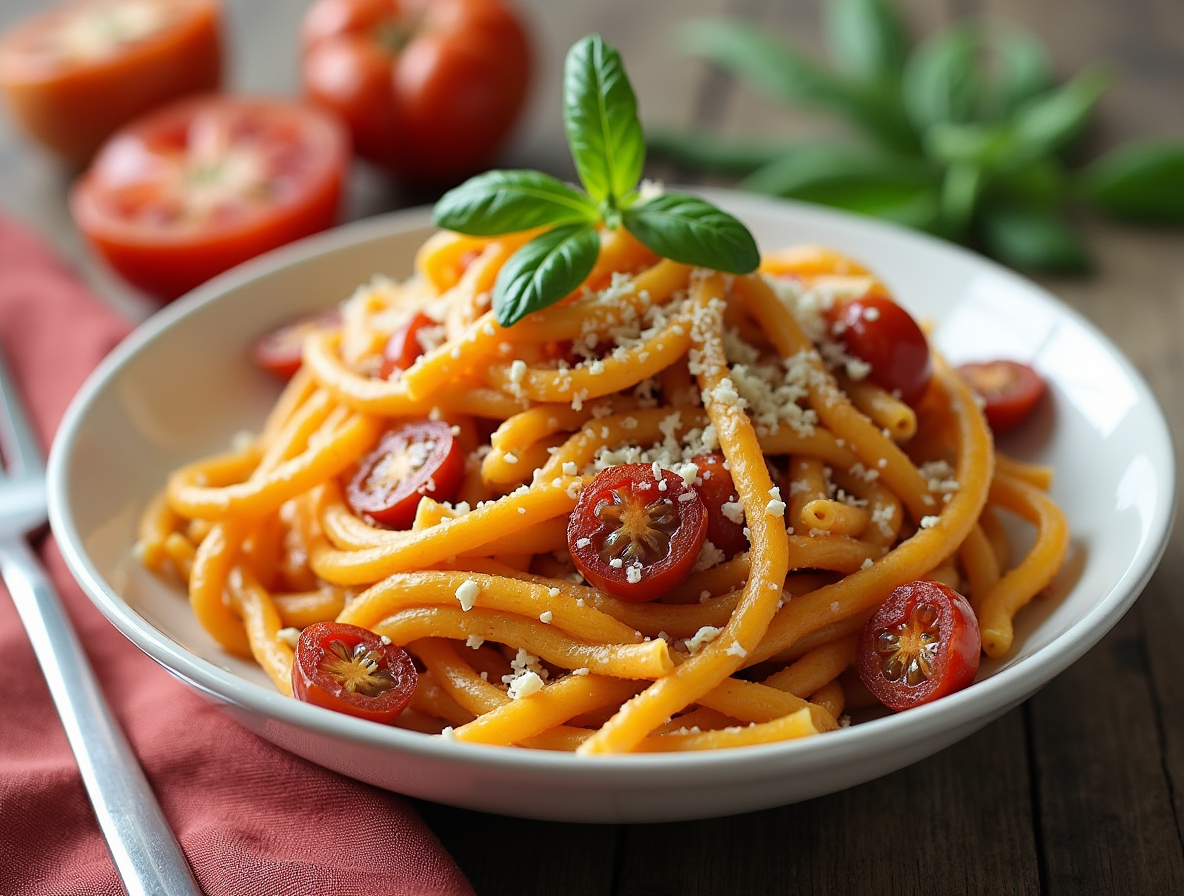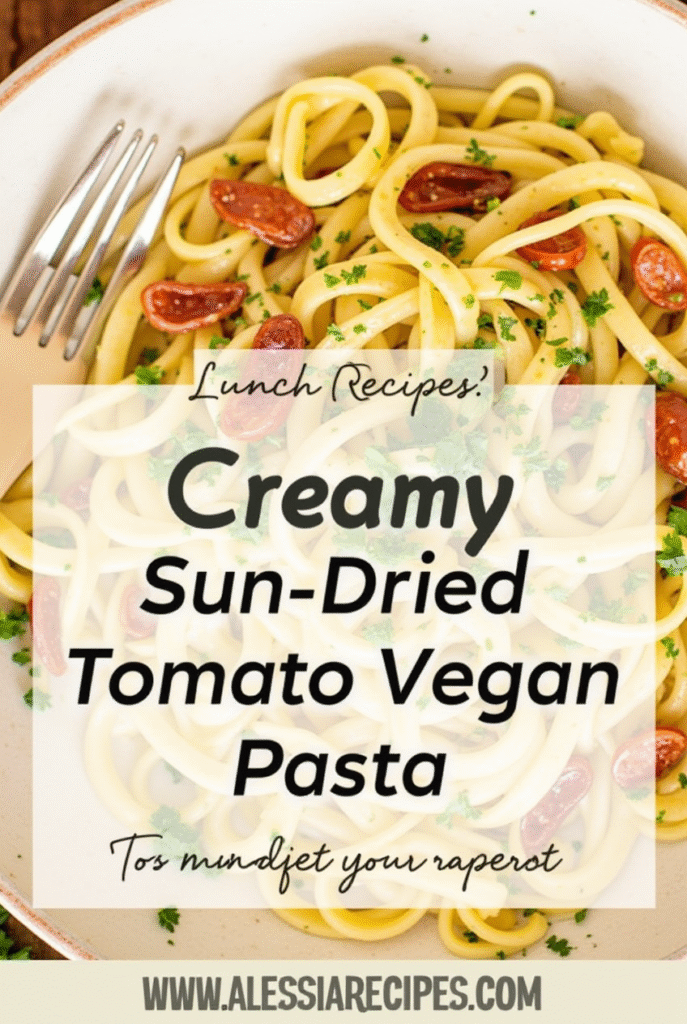How to Make the Creamiest Vegan Sun Dried Tomato Pasta (Better Than Restaurant)
Vegan sun dried tomato pasta has roots that stretch back to Italian cuisine, where sun-dried tomatoes were originally dried on ceramic rooftops around 700 AD. In fact, this creamy dish can rival meals found in fancy Italian restaurants while being incredibly simple to make at home. With just 6 ingredients and approximately 20 minutes of preparation time, you can create a restaurant-quality meal that’s perfect for busy weeknights.
Creating the creamiest pasta with coconut milk is easier than you might think. Full-fat canned coconut milk and nutritional yeast work together to create a velvety sauce without any dairy products. Additionally, sun-dried tomatoes bring an intensified flavor and impressive nutritional profile to this dish, being rich in vitamins, antioxidants, and fiber. If you prefer, cashew cream can also provide that luxurious texture that makes creamy vegan sun dried tomato pasta so satisfying. We’ve tested countless variations to bring you a recipe that truly delivers on both flavor and texture.
Choosing the Right Ingredients for Creamy Vegan Pasta
The foundation of any exceptional vegan sun dried tomato pasta lies in selecting quality ingredients. Making thoughtful choices about each component will transform your dish from good to restaurant-quality.
Sun-dried tomatoes: oil-packed vs. dry
Sun-dried tomatoes come in two primary forms, each offering distinct benefits for your creamy pasta. Oil-packed tomatoes come vacuum-sealed in jars with olive oil and often herbs or garlic. These are already softened and require no preparation before use. Furthermore, the oil itself becomes infused with rich tomato flavor, making it an excellent addition to your sauce.
Dry-packed sun-dried tomatoes, conversely, are typically sold in bags in the produce department and have a chewier texture. Before using them in your creamy vegan sun dried tomato pasta, they must be rehydrated in hot liquid for about 15-20 minutes. Although they require extra preparation, dry-packed varieties absorb surrounding flavors during cooking and expand when rehydrated, helping a small amount go further.
Coconut milk vs. cashew cream
For the creamiest vegan pasta sauce, both coconut milk and cashew cream offer excellent alternatives to dairy. Full-fat canned coconut milk provides immediate richness and requires no preparation. Essentially, it creates a velvety texture that clings beautifully to pasta.
Cashew cream, however, delivers unparalleled creaminess that closely mimics heavy cream. To prepare it, soak raw cashews in hot water, then blend with liquid until smooth. This versatile base works wonderfully in sun dried tomato pasta sauce, especially when you want a neutral flavor that won’t compete with your other ingredients.
Flavor boosters: garlic, basil, nutritional yeast
Creating depth in your creamy vegan sun dried tomato pasta requires strategic flavor enhancers. Fresh garlic provides aromatic foundation, while basil adds brightness that balances the richness of the sauce.
Nutritional yeast, often called “nooch,” remains a secret weapon in vegan cooking. This deactivated yeast delivers a nutty, cheesy flavor that complements the sweetness of sun-dried tomatoes. Just 2-3 tablespoons will transform your sauce into something distinctly savory and satisfying.
Best pasta types for creamy sauces
Not all pasta shapes perform equally with creamy sauces. Primarily, you want shapes that capture and hold sauce in their structure. Penne, fusilli, and ziti excel with sun dried tomato cream sauce because their ridges and hollows trap the sauce.
For a truly restaurant-quality experience, reserve some pasta cooking water before draining. The starchy water helps the sauce adhere to the pasta and achieves perfect consistency. This simple chef’s trick makes all the difference in creating that professional-quality creaminess.
How to Make the Creamy Sun Dried Tomato Sauce
Creating the perfect creamy sauce is where the magic happens in your vegan sun dried tomato pasta. The process combines simple techniques that maximize flavor while maintaining that silky texture we all crave.
Sautéing aromatics for depth
The foundation of any exceptional creamy vegan sun dried tomato pasta begins with properly sautéed aromatics. Start by heating olive oil in a skillet over medium heat, then add finely chopped onions or shallots. Allow them to cook slowly for about 5 minutes until translucent and fragrant. Subsequently, add minced garlic and continue cooking for another 1-2 minutes until softened but not browned. This slow cooking process releases natural sweetness from the aromatics, creating a flavor-packed base for your sauce.
For additional depth, you can add a small amount of dried herbs such as oregano or red pepper flakes at this stage. These initial minutes of sautéing are crucial as they build the foundational flavors that carry throughout the entire dish.
Blending the sauce: tools and tips
Once your aromatics are perfectly sautéed, it’s time to create that signature creamy texture. Generally, high-speed blenders yield the smoothest results for your vegan sun dried tomato sauce. Alternatively, an immersion blender works well if you prefer a slightly more textured finish.
When blending, combine your sautéed aromatics with either coconut milk or pre-soaked cashews, depending on your preference. For optimal creaminess, blend on high speed for 1-2 minutes until completely smooth. Remember to reserve some pasta cooking water – this starchy liquid helps thin the sauce to perfect consistency without diluting flavor.
Balancing flavors: sweet, tangy, and savory
The secret to restaurant-quality vegan sun dried tomato pasta lies in balancing competing flavors. Nutritional yeast adds cheesy depth, whereas a small squeeze of lemon juice brightens the entire dish. Indeed, a pinch of sweetener (such as a teaspoon of agave) can counterbalance tomato acidity.
For depth and umami, consider adding a splash of soy sauce or a tablespoon of tomato paste. Moreover, taste frequently throughout the process, making small adjustments until you achieve the perfect balance. Remember that salt enhances all flavors, but add it gradually as the sauce reduces and concentrates.
Cooking and Combining the Pasta
Properly cooking and combining your pasta is the crucial final step that distinguishes homemade vegan sun dried tomato pasta from restaurant-quality dishes. Even the most flavorful sauce can fall flat if the pasta isn’t cooked correctly or combined improperly.
Cooking pasta to al dente
Firstly, bring a large pot of water to a rolling boil before adding your pasta. For the perfect texture, add 1-2 tablespoons of salt per quart of water. This might seem excessive, but most of the salt remains in the water, and this step ensures your pasta has flavor on its own.
Cook your pasta until it reaches that perfect al dente state—tender yet still firm when bitten. Check your pasta a minute or two before the package suggests. For creamy sauces specifically, al dente pasta holds up better against the richness of coconut milk or cashew cream.
Combining sauce and pasta for best texture
Once your pasta reaches al dente, reserve about a cup of the starchy cooking water before draining. This pasta water is essential for creating the perfect creamy vegan sun dried tomato pasta as it helps thicken the sauce and allows it to cling better to your noodles.
Transfer your pasta directly to the pan with your sauce. Rather than rinsing the pasta, which removes beneficial starch, add it straight to your creamy sun dried tomato sauce. Simmer everything together for 1-2 minutes, stirring constantly to coat each strand. The pasta will continue absorbing flavor as it finishes cooking in the sauce.
Adding greens or protein for a full meal
To transform your creamy pasta with coconut milk into a complete meal, add protein and vegetables. Chickpeas make an excellent addition, providing 6-8 grams of protein per 1/2-cup serving. They slowly simmer and absorb the flavors of your sun dried tomato sauce.
For greens, simply toss a few handfuls of spinach, arugula, or kale into the pan just before serving. The residual heat will slightly wilt the greens while preserving their nutrients. Alternatively, frozen peas or roasted broccolini pair beautifully with creamy vegan sun dried tomato pasta.
This balanced approach ensures each bite contains pasta, sun dried tomato sauce, and nutritious add-ins, creating a satisfying meal that rivals any restaurant offering.
Serving, Storing, and Reheating Tips
After perfecting your vegan sun dried tomato pasta, maximize its enjoyment through proper serving, storage, and reheating techniques. These finishing touches truly elevate your culinary creation from homemade to restaurant-quality.
Best side dishes to pair with
Alongside your creamy vegan sun dried tomato pasta, consider serving a crisp green salad with a zesty vinaigrette to balance the richness of the coconut milk sauce. A simple Italian salad with creamy vegan Italian dressing creates a perfect contrast. Alternatively, crusty garlic bread offers a delightful textural complement and helps soak up any remaining sauce.
For a more substantial meal, roasted or steamed vegetables make excellent companions. Consider asparagus, broccoli, or broccolini which all pair beautifully with the creamy pasta. Surprisingly, whole roasted carrots can add a sweet counterpoint and vibrant color to your plate.
How to store leftovers without drying out
Fortunately, leftover vegan sun dried tomato pasta can maintain its quality when stored properly. Place cooled pasta in an airtight container within 2 hours of cooking and refrigerate at 40°F (4°C) or below. The pasta will keep for 3-5 days when stored this way.
To prevent your creamy pasta with coconut milk from drying out, drizzle a small amount of olive oil over the pasta before storing. Glass containers work particularly well as they don’t stain or harbor smells. Remember that gluten-free pastas might develop a less desirable texture after the first day or two.
Reheating tips to keep it creamy
Despite careful storage, coconut cream thickens when chilled, making your sauce quite a bit thicker than when freshly made. To revive its creaminess, gently reheat on the stovetop over low heat, adding a splash of vegetable broth, milk, or water. Stir frequently to prevent sticking and ensure even heating.
If using a microwave, place pasta in a microwave-safe dish with a few drops of water or sauce and cover. Heat in 30-second intervals, stirring between each until thoroughly heated. For baked dishes, cover with foil and warm in a 350°F (175°C) oven for about 20 minutes.
For the absolute best results, consider storing pasta and sauce separately when possible. This makes reheating the sauce to its original creaminess much easier.
Conclusion
Making the creamiest vegan sun dried tomato pasta truly stands within reach of any home cook. Throughout this guide, we’ve explored everything from selecting quality ingredients to mastering professional techniques that transform simple components into extraordinary meals. Certainly, the magic happens when full-fat coconut milk or cashew cream meets intensely flavored sun-dried tomatoes, creating that signature velvety texture without any dairy products.
This dish proves that plant-based cooking doesn’t require compromise. Instead, it offers a perfect balance of convenience and sophistication. The combination of properly sautéed aromatics, well-blended sauces, and perfectly cooked al dente pasta creates something genuinely special. Additionally, those little chef tricks—like reserving pasta water and finishing the pasta directly in the sauce—elevate your creation from good to restaurant-quality.
Beyond the basic recipe, we’ve seen how versatile this dish can be. You can transform it into a complete meal with protein additions like chickpeas or fresh greens for nutrition and color. Afterward, proper storage and reheating techniques ensure your leftovers maintain their creamy perfection.
Most importantly, this delicious vegan pasta requires just six ingredients and approximately 20 minutes to prepare—perfect for busy weeknights when you crave something extraordinary but lack extensive cooking time. Therefore, we encourage you to gather your ingredients, follow these steps, and discover just how amazing plant-based cooking can be. Your homemade vegan sun dried tomato pasta will undoubtedly impress both plant-based eaters and omnivores alike with its incredible flavor and luxurious texture.
FAQs
Q1. How can I make my vegan pasta sauce creamy without dairy? To achieve a creamy texture in vegan pasta sauce, use full-fat canned coconut milk or cashew cream. These alternatives provide a rich, velvety consistency similar to dairy-based cream sauces. Nutritional yeast can also be added for a cheesy flavor and extra creaminess.
Q2. What’s the best way to prepare sun-dried tomatoes for pasta? If using dry-packed sun-dried tomatoes, rehydrate them in hot water for 15-20 minutes before adding to your pasta sauce. For oil-packed tomatoes, they can be used directly from the jar. Both types will infuse your sauce with intense tomato flavor.
Q3. Which pasta shapes work best with creamy vegan sauces? Pasta shapes that capture and hold sauce well are ideal for creamy vegan sauces. Penne, fusilli, and ziti are excellent choices as their ridges and hollows trap the sauce effectively, ensuring each bite is full of flavor.
Q4. How can I enhance the flavor of my vegan sun-dried tomato pasta? To boost flavor, sauté aromatics like garlic and onions before adding them to your sauce. Incorporate herbs such as basil, and use nutritional yeast for a cheesy taste. Balancing flavors with a touch of lemon juice and a pinch of sweetener can also elevate the overall taste profile.
Q5. What’s the secret to achieving restaurant-quality creaminess in vegan pasta? The key to restaurant-quality creaminess is to reserve some pasta cooking water before draining. This starchy water helps the sauce adhere to the pasta and achieve the perfect consistency. Also, finish cooking the pasta directly in the sauce for 1-2 minutes, allowing it to absorb flavors and create a cohesive dish.


